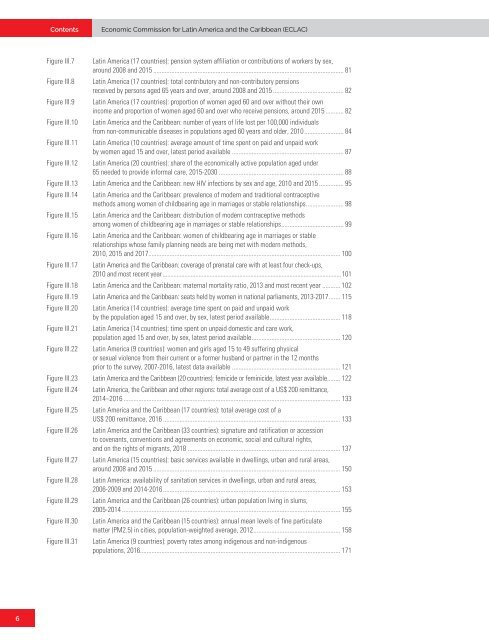Draft first regional report on the implementation of the Montevideo Consensus on Population and Development
This draft report seeks to give an account of progress in the implementation of the priority measures of the Montevideo Consensus on Population and Development in the region, as well as the differences between countries in terms of the degree of implementation. By highlighting relevant national experiences, it also seeks to facilitate the exchange of good practices among countries so that they can benefit from each other in their efforts to advance the implementation of the actions of the Montevideo Consensus.
This draft report seeks to give an account of progress in the implementation of the priority measures of the Montevideo Consensus on Population and Development in the region, as well as the differences between countries in terms of the degree of implementation. By highlighting relevant national experiences, it also seeks to facilitate the exchange of good practices among countries so that they can benefit from each other in their efforts to advance the implementation of the actions of the Montevideo Consensus.
You also want an ePaper? Increase the reach of your titles
YUMPU automatically turns print PDFs into web optimized ePapers that Google loves.
C<strong>on</strong>tents<br />
Ec<strong>on</strong>omic Commissi<strong>on</strong> for Latin America <strong>and</strong> <strong>the</strong> Caribbean (ECLAC)<br />
Figure III.7 Latin America (17 countries): pensi<strong>on</strong> system affiliati<strong>on</strong> or c<strong>on</strong>tributi<strong>on</strong>s <strong>of</strong> workers by sex,<br />
around 2008 <strong>and</strong> 2015..................................................................................................................... 81<br />
Figure III.8 Latin America (17 countries): total c<strong>on</strong>tributory <strong>and</strong> n<strong>on</strong>-c<strong>on</strong>tributory pensi<strong>on</strong>s<br />
received by pers<strong>on</strong>s aged 65 years <strong>and</strong> over, around 2008 <strong>and</strong> 2015............................................ 82<br />
Figure III.9 Latin America (17 countries): proporti<strong>on</strong> <strong>of</strong> women aged 60 <strong>and</strong> over without <strong>the</strong>ir own<br />
income <strong>and</strong> proporti<strong>on</strong> <strong>of</strong> women aged 60 <strong>and</strong> over who receive pensi<strong>on</strong>s, around 2015............ 82<br />
Figure III.10 Latin America <strong>and</strong> <strong>the</strong> Caribbean: number <strong>of</strong> years <strong>of</strong> life lost per 100,000 individuals<br />
from n<strong>on</strong>-communicable diseases in populati<strong>on</strong>s aged 60 years <strong>and</strong> older, 2010......................... 84<br />
Figure III.11 Latin America (10 countries): average amount <strong>of</strong> time spent <strong>on</strong> paid <strong>and</strong> unpaid work<br />
by women aged 15 <strong>and</strong> over, latest period available..................................................................... 87<br />
Figure III.12 Latin America (20 countries): share <strong>of</strong> <strong>the</strong> ec<strong>on</strong>omically active populati<strong>on</strong> aged under<br />
65 needed to provide informal care, 2015-2030............................................................................. 88<br />
Figure III.13 Latin America <strong>and</strong> <strong>the</strong> Caribbean: new HIV infecti<strong>on</strong>s by sex <strong>and</strong> age, 2010 <strong>and</strong> 2015................ 95<br />
Figure III.14 Latin America <strong>and</strong> <strong>the</strong> Caribbean: prevalence <strong>of</strong> modern <strong>and</strong> traditi<strong>on</strong>al c<strong>on</strong>traceptive<br />
methods am<strong>on</strong>g women <strong>of</strong> childbearing age in marriages or stable relati<strong>on</strong>ships........................ 98<br />
Figure III.15 Latin America <strong>and</strong> <strong>the</strong> Caribbean: distributi<strong>on</strong> <strong>of</strong> modern c<strong>on</strong>traceptive methods<br />
am<strong>on</strong>g women <strong>of</strong> childbearing age in marriages or stable relati<strong>on</strong>ships....................................... 99<br />
Figure III.16 Latin America <strong>and</strong> <strong>the</strong> Caribbean: women <strong>of</strong> childbearing age in marriages or stable<br />
relati<strong>on</strong>ships whose family planning needs are being met with modern methods,<br />
2010, 2015 <strong>and</strong> 2017..................................................................................................................... 100<br />
Figure III.17 Latin America <strong>and</strong> <strong>the</strong> Caribbean: coverage <strong>of</strong> prenatal care with at least four check-ups,<br />
2010 <strong>and</strong> most recent year...................................................................................................................101<br />
Figure III.18 Latin America <strong>and</strong> <strong>the</strong> Caribbean: maternal mortality ratio, 2013 <strong>and</strong> most recent year............ 102<br />
Figure III.19 Latin America <strong>and</strong> <strong>the</strong> Caribbean: seats held by women in nati<strong>on</strong>al parliaments, 2013-2017........ 115<br />
Figure III.20 Latin America (14 countries): average time spent <strong>on</strong> paid <strong>and</strong> unpaid work<br />
by <strong>the</strong> populati<strong>on</strong> aged 15 <strong>and</strong> over, by sex, latest period available............................................ 118<br />
Figure III.21 Latin America (14 countries): time spent <strong>on</strong> unpaid domestic <strong>and</strong> care work,<br />
populati<strong>on</strong> aged 15 <strong>and</strong> over, by sex, latest period available....................................................... 120<br />
Figure III.22 Latin America (9 countries): women <strong>and</strong> girls aged 15 to 49 suffering physical<br />
or sexual violence from <strong>the</strong>ir current or a former husb<strong>and</strong> or partner in <strong>the</strong> 12 m<strong>on</strong>ths<br />
prior to <strong>the</strong> survey, 2007-2016, latest data available................................................................... 121<br />
Figure III.23 Latin America <strong>and</strong> <strong>the</strong> Caribbean (20 countries): femicide or feminicide, latest year available......... 122<br />
Figure III.24 Latin America, <strong>the</strong> Caribbean <strong>and</strong> o<strong>the</strong>r regi<strong>on</strong>s: total average cost <strong>of</strong> a US$ 200 remittance,<br />
2014–2016..................................................................................................................................... 133<br />
Figure III.25 Latin America <strong>and</strong> <strong>the</strong> Caribbean (17 countries): total average cost <strong>of</strong> a<br />
US$ 200 remittance, 2016............................................................................................................. 133<br />
Figure III.26 Latin America <strong>and</strong> <strong>the</strong> Caribbean (33 countries): signature <strong>and</strong> ratificati<strong>on</strong> or accessi<strong>on</strong><br />
to covenants, c<strong>on</strong>venti<strong>on</strong>s <strong>and</strong> agreements <strong>on</strong> ec<strong>on</strong>omic, social <strong>and</strong> cultural rights,<br />
<strong>and</strong> <strong>on</strong> <strong>the</strong> rights <strong>of</strong> migrants, 2018.............................................................................................. 137<br />
Figure III.27 Latin America (15 countries): basic services available in dwellings, urban <strong>and</strong> rural areas,<br />
around 2008 <strong>and</strong> 2015................................................................................................................... 150<br />
Figure III.28 Latin America: availability <strong>of</strong> sanitati<strong>on</strong> services in dwellings, urban <strong>and</strong> rural areas,<br />
2006-2009 <strong>and</strong> 2014-2016............................................................................................................. 153<br />
Figure III.29 Latin America <strong>and</strong> <strong>the</strong> Caribbean (26 countries): urban populati<strong>on</strong> living in slums,<br />
2005-2014...................................................................................................................................... 155<br />
Figure III.30 Latin America <strong>and</strong> <strong>the</strong> Caribbean (15 countries): annual mean levels <strong>of</strong> fine particulate<br />
matter (PM2.5) in cities, populati<strong>on</strong>-weighted average, 2012...................................................... 158<br />
Figure III.31 Latin America (9 countries): poverty rates am<strong>on</strong>g indigenous <strong>and</strong> n<strong>on</strong>-indigenous<br />
populati<strong>on</strong>s, 2016.......................................................................................................................... 171<br />
6


















